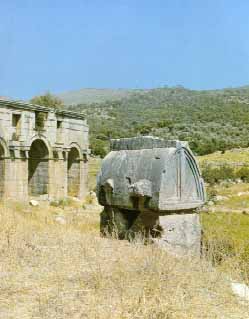Lycia is famous for the large number of
exceptionally beautiful funerary monuments. These take the form of rock
tombs, sarcophagi, tumuli and pillars.
 The
Rock Tombs: These tombs, carved out of the hard rock, are of three types:
The
Rock Tombs: These tombs, carved out of the hard rock, are of three types:
- Simple: These are in the form of rectangular niches. This type of tomb
can be seen at Golbasi and Pinara.
- House-type Tombs: The name itself is sufficient to describe the shape
of these tombs. These too are hewn out of the rock. The rock tombs at Myra
are the best preserved examples of this type.
- Temple Tombs: Having a façade like that of a Greek temple with portico,
cornice and pediment. These, like the tombs at Telmessos and Limyra, were
constructed under Greek influence.
The Sarcophagi: These are the second type of funerary monument. These
must have been exceptionally fine examples of stone work, but the passage of
time has destroyed both the workmanship and the decoration. The best
examples are those found at Golbasi and Xanthos.
The Tumuli: These are limestone structure with a very large diameter. The
grave-chamber is aligned in a north-south direction. Three such tumuli can
be seen at Phellus, another three at Seyret, and one at Koybasi.
 The
Pillar Tombs: This kind of tomb displays a very unusual type of architecture
consisting of a stepped base supporting a monolithic pillar is the grave
chamber hewn out of a single block of stone and covered with stepped lid.
The
Pillar Tombs: This kind of tomb displays a very unusual type of architecture
consisting of a stepped base supporting a monolithic pillar is the grave
chamber hewn out of a single block of stone and covered with stepped lid.
The grave-chamber is surrounded by a frieze. The best example of this
type of monument is the Harpy Tomb at Xanthos, the friezes from which are
known preserved in the British Museum. This is known as the Lion Pillar.
This type of funerary monument was constructed in commemoration of the
victories achieved by the dynasty of the city. These pillars, apart from the
"Inscribed Pillar" at Xanthos, are totally devoid of inscriptions. The "Inscribed
Pillar", however, is completely covered with an inscription in the Lycian
language accompanied by a summary in Greek on the other side.